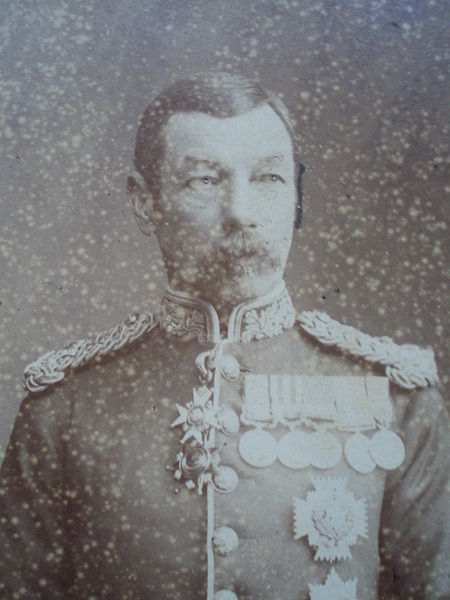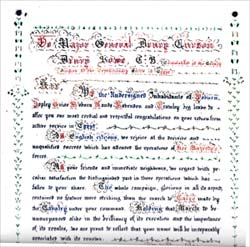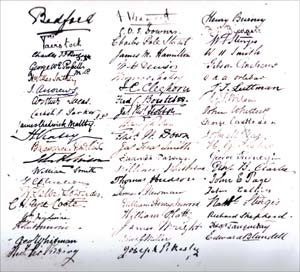1882 Memorial Scroll from the townsfolk of Woburn Sands to Major General Drury Curzon Drury Lowe
Drury Curzon Drury Lowe had a long and distinguished career in the British Army. He had been feted on a triumphal tour of England on his return from the Zulu Wars of 1879, at the age of 49, to his home in Aspley Guise, where he lived at “The Drive” on The Mount. In September 1879, local businessman Henry Down chaired a committee to welcome Colonel Drury Lowe home. Lowe had returned on the ‘Conway Castle’, which took three weeks to sail from Capetown. He had commanded the 17th Lancers, known as “Binghams Dandies”. After the massacre at Isandhlwana, which led to the defence of Rourke’s Drift, (immortalised in the 1964 Michael Caine film “Zulu”), the 17th Lancers were alerted at their base-camp in Leeds. Their commanding officer, Lt. Col. Thomas Gonne, shot himself in the foot during pistol practice the same day and so Col. Lowe had been promoted. They left England with 622 men and 422 horses.
The 17th Lancers made a charge at the battle of Ulandi, which was their first action since the Crimea. Lowe had just ordered the charge, when he was struck on the back by a spent bullet, but it hit his leather belt and although it felled him from his horse, he quickly re-saddled and followed the charge that he should have led.
Henry Down had four ‘Triumphal Arches’ erected along the High Street by Goodall & Sons and the Fenny Stratford Brass Band were informed that they would be needed at the drop of a hat when word was received that the Colonel was due on the train. Members of the Woburn Rifle Volunteers and the Bucks Yeomanry formed the Guard of Honour and an honorary supper was held at the Swan Hotel.

Three years later, and General Drury Lowe was again in the headlines, after he commanded a cavalry division of the 7th Dragoons and three squadrons of Household Cavalry, which had been first to reach Cairo in the 1882 Egyptian War. A local revolt had taken place, and troops were sent to restore order. After victories at Kassassin and Tel El-Kebir, the cavalry was sent under cover of night to reach Cairo. They arrived at about 3a.m. and so surprised the remaining enemy, who were holding the city, that they surrendered immediately.
This is how The Times reported it:
“General Drury-Lowe Yesterday at Woburn Sands, Bedfordshire, an address was presented to General Drury-Lowe, who resides in the neighbourhood by the Duke of Bedford in the name of the inhabitants of the district. The Mayor and Corporation of Bedford and an influential company were present. General Drury-Lowe, in acknowledging the compliment, said that it was due to the gallantry of the troops he had the honour to command, and to some slight regard, which was, perhaps entertained for himself as a neighbour. He was not vain enough to imagine the successes in Egypt were in any way due to and peculiar ability on his part. It was solely and entirely owing to the endurance, the discipline and the thorough devotion to duty of the regiments comprising the expeditionary force, and, he might add, with pride, to the efficiency of the cavalry division under his command. No words of his could describe the gallantry shown by officers and men throughout the whole of the campaign. The charge at Kassassin was a very critical thing, but there was no hesitation, and had the enemy been 10 times their actual number, and been composed of the finest troops in Europe in place of the Egyptians, who were, however, not to be despised, the result would have been the same. He particularly wished to mention the Indian Cavalry, which had throughout exhibited the greatest ability, and maintained their right to ride at the side of their British comrades. The honour and credit of the whole campaign were due to Sir Garnet Wolesley. Before he left the ship in which he sailed from England, he knew that his duty with the cavalry was to get to Cairo; that was planned by Sir Garnet Wolesley before they left England. General Drury Lowe’s speech was frequently interrupted by cheering. The Duke and Duchess, General Drury-Lowe, Lord Charles Russell and a few other friends were subsequently entertained at luncheon at the vicarage by the Rev J M Hamilton, vicar of the parish.”
The following detail of the Egyptian campaign comes from the excellent website britishbattles.com:
Egypt in the late 19th Century, ruled by the Khedive, remained a nominal part of the Turkish Ottoman Empire. Britain and France maintained a substantial interest in the country due to the Suez Canal, in which both countries had invested heavily and which provided the most direct route to their Asian colonies; India and Australia for Britain and Indochina for France. In the 1870s Egypt, through mismanagement and corruption, lurched towards financial collapse and political instability. Britain and France installed a commission to supervise Egypt’s government. In 1881 Colonel Ahmed Arabi Bey, a native Egyptian officer of the Egyptian Army with other Egyptian officers launched a revolt against the Khedive and the British and French. A British naval squadron under Admiral Seymour bombarded the defences of Alexandria Egypt’s main port on the northern coast on 11th July 1882. A British military force assembled under Lieutenant-General Sir Garnet Wolseley to invade Egypt, with the purpose of capturing Cairo and restoring the Khedive as nominal ruler and Anglo-French control of the country.
The leading elements of the British force landed at Alexandria in the second week of August 1882. The aims of the force were to secure the Suez Canal that ran North-South in the East of Egypt and then to march on Cairo, the capital of the country, which the rebels were threatening to destroy in the event of an invasion.
An Anglo-Indian force was sent from India to join the British contingent in the Suez Canal. The landing at Alexandria was a feint. General Wolseley concealed his true plan from everyone except his immediate staff, which was to land at Ismailia, at the Northern end of the Suez Canal and to march West to Cairo, attacking Arabi’s army in its positions at Tel-El-Kebir on the railway and main irrigation canal.
The British contingent landed at Ismailia around 20th August 1882 securing the local barracks and canal facilities, while the Anglo-Indian contingent came up the canal from the Persian Gulf in the South.
At 4am on 24th August 1882 General Wolseley’s army marched out of Ismailia along the line of the railway, moving West towards Cairo, to attack Arabi’s army at the town of Tel-El-Kebir situated on the line of the railway and irrigation canal.
Arabi’s army had in the meanwhile dammed the irrigation canal that ran alongside the railway with the aim of cutting off the water supply to the Anglo-Indian army and the town of Ismailia.
General Graham’s brigade was pushed forward to Kassassin where there was a lock on the irrigation canal. Graham’s brigade formed in position across the railway line and canal.
Late on 24th August 1882 an Egyptian force, comprising guns and infantry, appeared to the North of Graham’s position. Graham engaged them. Seeing that the Egyptians’ flank was exposed, Graham directed Major General Drury-Lowe to attack the Egyptians with the cavalry brigade.
Drury-Lowe lead forward his mounted force comprising a composite regiment of Household Cavalry (a squadron from each of 1st Life Guards, 2nd Life Guards and the Royal Horse Guards, the ‘Blues’) and 7th Dragoon Guards with 4 guns of N/A Battery, Royal Horse Artillery.
Drury-Lowe was aided in reaching the battle line by the gun flashes in the gathering darkness. The first fire was opened by the Egyptians. Drury-Lowe engaged them with his guns and then launched the Household Cavalry in a charge. The Egyptian infantry were swept away and their guns abandoned and captured in the ‘Moonlight Charge’ of the Battle of Kassassin.
Informed of this success Graham returned to his positions at Kassassin. General Sir Garnet Wolseley completed the build up of his army around the Kassassin position by 12th September 1882. Arabi’s Egyptian army lay at Tel-El-Kebir some 6 miles distant. Tel-El-Kebir comprised a small town to the South of the line of the canal and the Cairo-Ismailia railway that ran parallel and to the North of the canal.
Over the preceding weeks the Egyptian army of some 20,000 soldiers with 59 guns, some of them modern German Krupp-made weapons, had built a length of entrenchment starting with redoubts at the canal and railway and stretching north some 3 miles to the end of a raised section of ground. A second section of entrenchment covered the Egyptian camp to the rear.
General Wolseley resolved to attack the Egyptian line at dawn, following a night approach march. His army formed up with the 2nd Division, commanded by Lieutenant General Sir Edward Hamley, on the left; the Highland Brigade leading with the second brigade of the Division in reserve immediately to its rear. The 1st Division took the right with Major General Graham’s brigade to the front and the Guards Brigade commanded by the Duke of Connaught, in reserve. The guns, commanded by Colonel Goodenough, advanced in the area between the 2 reserve brigades. The cavalry brigade commanded by Major General Drury-Lowe, augmented to a division by the addition of the Indian regiments, took the right of the army, conforming to the Guards Brigade, its role being to sweep around the Egyptian flank once the infantry had stormed the entrenchments and make for Cairo to prevent the destruction of the Egyptian capital by Arabi’s rebels.
The Indian brigade was to advance along the canal/railway line on the South side, to clear the Egyptian redoubts in that area, and take the town of Tel-El-Kebir, before moving on to the next station up the line, Zag-a-Zig.
The direction of the night-time advance was to be supervised by Lieutenant Rawson, Royal Navy, navigating by the stars from the left flank.
The night march to the entrenchments went surprisingly smoothly, except that the advancing army drifted to its right. Dawn broke with the Highland Brigade within 150 yards of the Egyptian line. A heavy fire immediately broke out. The 4 regiments of the Highland Brigade, led by its commander, Major General Allison, and General Hamley, the Divisional Commander, stormed into the entrenchments, the two centre regiments, the Gordons and Camerons leading. The Black Watch on the right of the brigade found the resistance hard to overcome, until supported by 3rd Battalion the King’s Royal Rifle Corps from the divisional reserve. On the left the Highland Light Infantry were unable to break into the entrenchments until reinforced by the Duke of Cornwall’s Light Infantry from the reserve brigade.
On the right, General Graham’s brigade met heavy resistance but drove the Egyptians from their trenches with the support of guns from the centre.
Following the success of the infantry attack, General Drury-Lowe took his cavalry division in a sweep around the Egyptian left flank and rode down the Egyptian rear towards the bridge crossing the canal into Tel-El-Kebir, accelerating the route of the retreating Egyptian troops.
To the South of the canal, the Seaforth Highlanders attacked the Egyptian redoubt while and 20th Punjabis (Brownlow’s) moved around the Egyptian right flank and stormed a village from which fire was being directed, both battalions supported by 7th Bengal Native Infantry and 29th Bombay Native Infantry.
The Indian brigade then moved into the town of Tel-El-Kebir. The battle was finished with the Egyptian army in rout.
Following the battle the cavalry division secured Cairo on 14th September 1882 and accepted the surrender of Arabi. On 25th September 1882 the Khedive re-entered his capital escorted by British and Indian troops.
Drury Curzon Drury Lowe died in 1908. The Drury Lowe family archives are deposited in the Hallward Library at the University of Nottingham, where a scroll survives that the local dignitaries gave to Major Gen. Drury Lowe to congratulate him.

Transcription:
“To Major General Drury Curson Drury Lowe, C.B. Commander of the cavalry division of the Expeditionary force in Egypt.
Sir, we, the undersigned inhabitants of Woburn, Aspley Guise, Woburn Sands, Wavendon and Crawley beg leave to offer you our most cordial and respectful congratulations on your return from active service in Egypt.
As English citizens, we rejoice at the decisive and unqualified success which has attended the operations of Her Majesty’s forces.
As you friends and immediate neighbours, we regard with particular satisfaction the distinguished part in those operations which has fallen to your share. The whole campaign, glorious in all its aspects, contained no feature more striking than the march to Cairo made by the Cavalry under your command. Holding that march to be unsurpassed alike in brilliancy of its execution and the importance of its results, we are proud to reflect that your name will be inseparably associated with its renown.
With earnest hope that you and Mrs Drury Lowe may live to enjoy, in health and happiness, the honour which justly belongs to so conspicuous and so memorable an achievement.
We beg to subscribe ourselves, very faithfully yours,
The Duke of Bedford
The Marquis of Tavistock
Lord Charles J F Russell J.P.
George W. E. Russell M.P.
H. Willes Southey
Rev. J. Andrews
Arthur Lucas
Carlisle S Parker
Rev. James Chadwick Maltby
Dr. H. Veasey
B. Lawrence Hawkins
John Robinson
William Smith
G. C Mahon
W. Selby Lowndes
C. H. Eyre Coote
Rev. William Jendwine
Robert Jendwine
George Whitman
Thomas Pickering
F. Bassett
C. O. S. Downes
Charles Pole Stuart J. P.
James M. Hamilton
W. H. Denison
Thomas Swabey
J. C. Cleghorn
Fred C. Boultbee
James Thomas Hobson J.P.
Henry Down
Fred. W. Down
James Francis Smith
Frederick Parsons
William Whitbread
Thomas Hudson
Thomas S. Newman
William Henry Inwood
William Plaitt
James Wright
Edward G Miller
Joseph Pikesley
Rev. Henry Burney
B. S. Budgett
F W. Sturges
W. H. Smith
Gibson Andrews
O. R. A. Orlebar
J. T. Luttman
J. T. Wilson
John Whitlock
George Castleden
John McKay
H. G. Fisher
George Turney
George B. Clarke
John E. Page
John Collins
Nathaniel Sturgis
Rev. Richard Shepherd
Fred Tanqureray
Edward Blundell

[Document images courtesy of the Manuscripts and Special Collections department, at The University of Nottingham. Document reference Dr 2F 13.]
Page last updated Jan. 2019.
